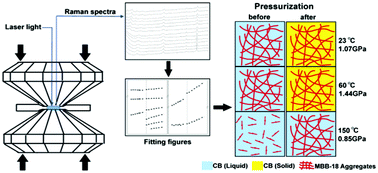Effect of temperature on self-assembly/disassembly transition of dialkylurea supramolecular gels at high pressure†
Abstract
Using 1-methyl-2,4-bis(N′-octadecaneureido)benzene (MBB-18) as a

* Corresponding authors
a
School of Chemistry and Chemical Engineering, Huazhong University of Science and Technology, Wuhan 430074, China
E-mail:
yjyang@mail.hust.edu.cn
Fax: 86-27-87543632
Tel: 86-27-87547141
b The High Pressure Research Center of Science and Technology, Zhengzhou University of Light Industry, Zhengzhou 450002, China
Using 1-methyl-2,4-bis(N′-octadecaneureido)benzene (MBB-18) as a

 Please wait while we load your content...
Something went wrong. Try again?
Please wait while we load your content...
Something went wrong. Try again?
H. Huang, X. Zhu, L. Su, H. Wang and Y. Yang, RSC Adv., 2013, 3, 11854 DOI: 10.1039/C3RA41540F
To request permission to reproduce material from this article, please go to the Copyright Clearance Center request page.
If you are an author contributing to an RSC publication, you do not need to request permission provided correct acknowledgement is given.
If you are the author of this article, you do not need to request permission to reproduce figures and diagrams provided correct acknowledgement is given. If you want to reproduce the whole article in a third-party publication (excluding your thesis/dissertation for which permission is not required) please go to the Copyright Clearance Center request page.
Read more about how to correctly acknowledge RSC content.
 Fetching data from CrossRef.
Fetching data from CrossRef.
This may take some time to load.
Loading related content
